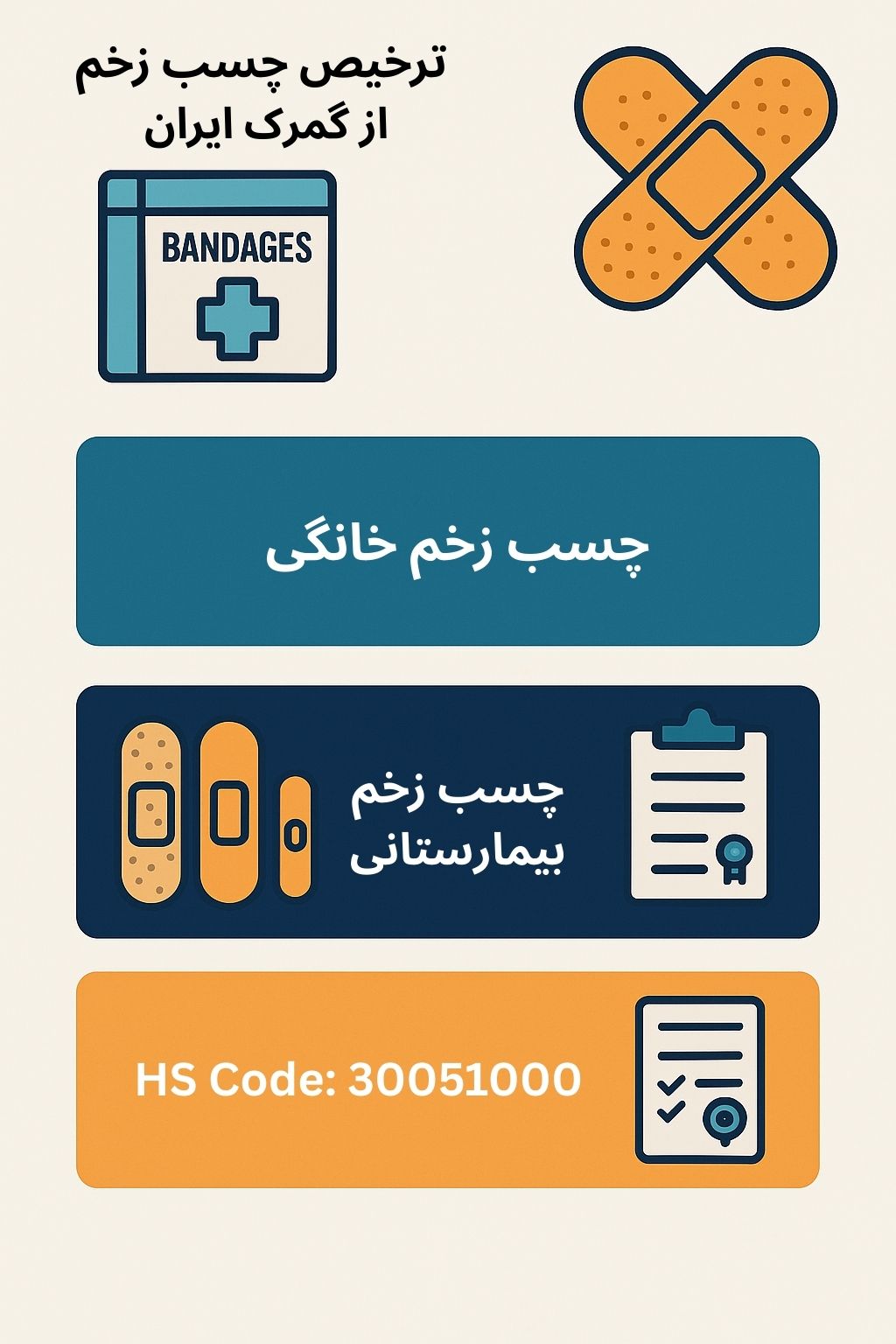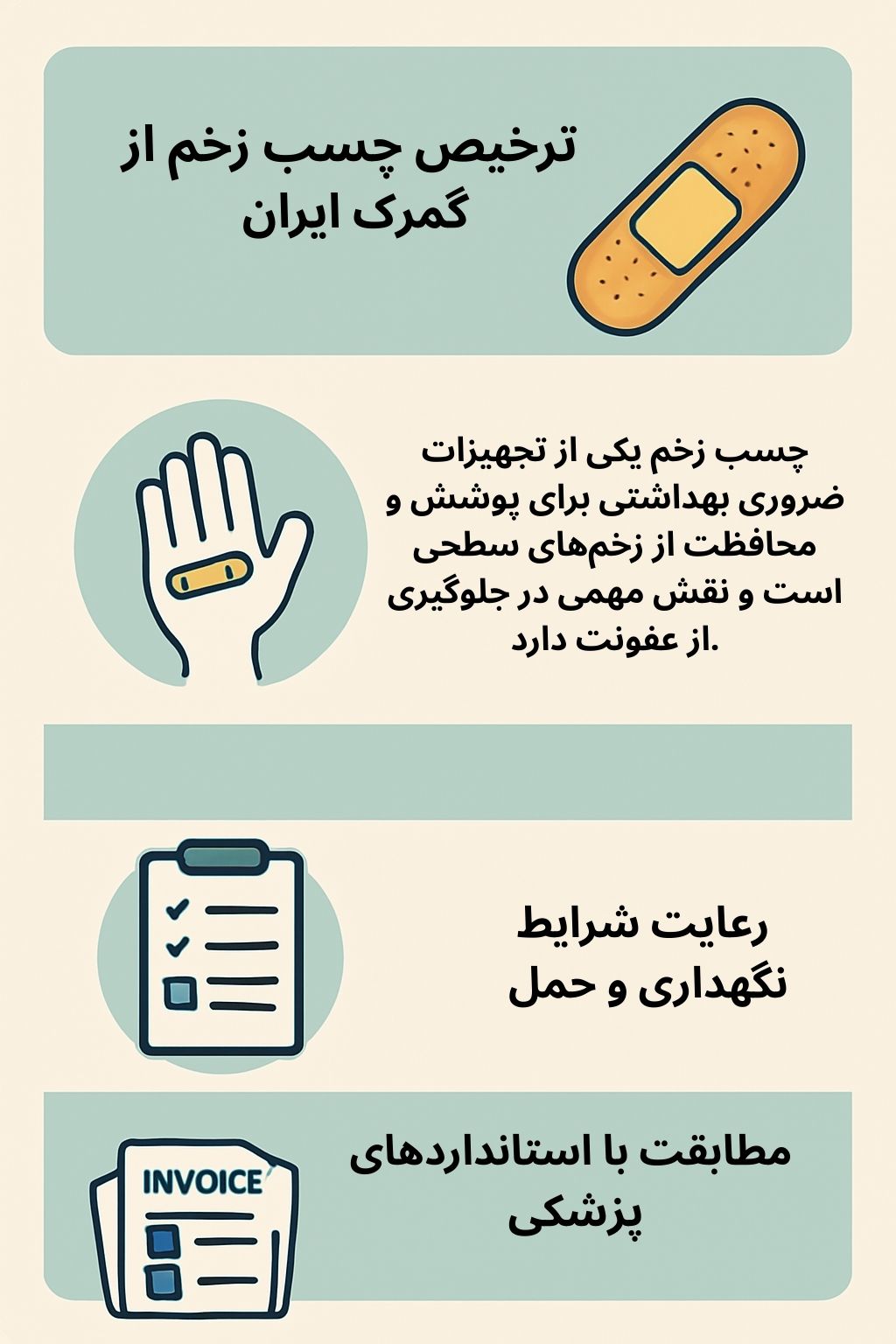Customs Clearance of Adhesive Bandages in Iran (HS Code, Documents & Permits)
Adhesive bandages (Adhesive Bandages) are among the essential items in the healthcare industry. Due to their vital role in primary medical care and their direct connection to public health, they are subject to strict customs and health controls. Importing this product requires strict compliance with regulations and obtaining the necessary permits, since it is considered a sensitive medical device. This product is governed by international and national standards, and multiple technical and legal points must be observed for import.
For an accurate estimate of time and cost for adhesive bandages customs clearance, contact the experts at Saba Tarkhis.
Immediate free consultation
1) Detailed Description of Adhesive Bandages
Technical Specifications of Adhesive Bandages
An adhesive bandage consists of several distinct layers, each designed for a specific function. These layers include:
- Outer layer: Usually made of flexible fabrics, durable polymers, or plastic to provide a protective barrier without harming the skin and with high resistance to moisture and contamination.
- Central absorbent layer: Responsible for absorbing wound exudate and preventing contaminants and microbes from entering the wound.
- Adhesive layer: Must be strong yet non-irritating to the skin and easy to remove.
- Special layers: Some adhesive bandages contain antiseptic properties to prevent wound infections.
Main Applications
- Protecting superficial wounds: By creating a protective barrier, adhesive bandages protect small wounds such as cuts, abrasions, or superficial wounds from infection and contamination.
Infection prevention: Some adhesive bandages contain antiseptic agents effective in preventing infection in minor wounds.
Use in various environments: Some bandages are water-resistant for humid environments like pools or showers. Hypoallergenic bandages are designed for sensitive skin to prevent allergic reactions.
2) Types of Adhesive Bandages & Uses + HS Code
All the following types are classified under HS Code: 30051000:
| Type | Use/Feature | HS Code |
|---|---|---|
| Standard adhesive bandage | General use for superficial wounds | 30051000 |
| Waterproof bandage | Moisture-resistant for humid environments | 30051000 |
| Hypoallergenic | Suitable for sensitive skin; minimizes irritation | 30051000 |
| Antiseptic | Contains antiseptics such as benzalkonium chloride | 30051000 |
| Fabric | Lightweight and breathable for daily use | 30051000 |
| For children | Patterned; suitable for delicate children’s skin | 30051000 |
| Large size | Greater coverage for larger wounds | 30051000 |
| Elastic | For high-movement areas like elbows and knees | 30051000 |
Final classification depends on material, dimensions, packaging, and hypoallergenic/antiseptic features.
3) Key Points in Adhesive Bandages Customs Clearance
- Full document consistency: Seller invoice, packing list, bill of lading, and declaration must match.
- Obtain health permits: Permit from Iran’s Food and Drug Administration (Ministry of Health) is required before clearance.
- Standards compliance: Provide conformity documents with national/international standards such as ISO and CE.
- Correct HS classification: Use 30051000 to avoid tariff disputes.
- Quality control & expiry: Ensure label, lot number, and dates match the documents.
4) Customs Tariff (HS Code)
The customs tariff for adhesive bandages is classified under HS Code 30051000. This code covers medical and sanitary products related to wound care and is part of the medical equipment and supplies group. Using this code is critical in customs procedures because tariffs and import taxes are determined based on it.
5) Special Conditions for Import and Export of Adhesive Bandages
Due to their variety and high quality, adhesive bandages are imported to Iran from various countries. China is one of the largest producers and exporters of adhesive bandages in the world, capturing a major share of the global market thanks to low production costs and acceptable quality. Germany is also a major exporter due to advanced technologies and high production standards. India and Turkey are highly active in this field and export to Iran and other markets.
Exports of Adhesive Bandages from Iran
In recent years, Iranian manufacturers have penetrated regional markets by improving product quality and meeting international standards. Iraq, Afghanistan, Armenia, and other Central Asian countries are among the main destinations for Iranian adhesive bandage exports. Leveraging modern technologies and competitive pricing, Iranian producers have been able to meet part of regional demand, and interest in Iranian products in this field continues to grow.
6) Iran Market: Imports & Exports, Countries of Origin/Destination
Adhesive bandages are imported to Iran from diverse origins; China holds a large share due to low production costs and product variety. Germany for advanced technology and quality, and India and Turkey are also active. In recent years, Iranian producers have begun regional exports (Iraq, Afghanistan, Armenia, and some Central Asian countries) by upgrading quality and complying with standards.
7) Trade Volume: Iran’s Imports & Exports + Global Turnover
The volume of adhesive bandage imports into Iran has increased significantly, driven by rising demand across the country’s healthcare sectors. As a key importer in the region, Iran sources from multiple countries such as China, Germany, Turkey, and India. With population growth and development of health infrastructure, demand in Iran continues to rise.
Conversely, exports from Iran have also grown. By increasing production capacity and improving product quality, domestic manufacturers have been able to supply part of regional markets. Although exports are still smaller than imports, they are gradually rising, and Iran could become a reputable regional exporter of this product.
According to global statistics, the financial turnover of the adhesive bandage market has increased markedly in recent years. Rising demand in developing countries and greater attention to hygiene and medical products in developed countries are key drivers. Estimates indicate the global market turnover for adhesive bandages amounts to billions of dollars and is still growing. China, Germany, the United States, and South Korea are among the largest global exporters, while the United States, Japan, France, and Iran are counted among the major importers worldwide.
8) Global Market: Major Exporters & Importers
Major Exporters
- China
- Germany
- South Korea
- United States
Major Importers
- United States
- Japan
- France
- Iran (regional level)

9) Required Documents for Clearance of Adhesive Bandages
- Adhesive bandages are among the most widely used products in healthcare, produced in various types to meet different user needs. Each type is categorized by specific features and applications and shares a common customs tariff code.
1. Standard Adhesive Bandages
Designed for superficial, small wounds and among the most common types. Materials are typically fabric or plastic and they are found in all first-aid kits.
Customs Tariff (HS Code): 30051000
2. Waterproof Adhesive Bandages
Engineered to resist moisture. Suitable for wet environments such as pools, showers, or places with frequent water exposure.
Customs Tariff (HS Code): 30051000
3. Hypoallergenic Adhesive Bandages
Produced for people with sensitive skin. Designed to avoid allergic reactions and prevent skin damage.
Customs Tariff (HS Code): 30051000
4. Antiseptic Adhesive Bandages
In addition to protection, these contain antiseptics such as benzalkonium chloride to prevent bacterial infections and are well-suited for open wounds.
Customs Tariff (HS Code): 30051000
5. Fabric Adhesive Bandages
Made from lightweight, breathable materials that sit comfortably on the skin. Highly flexible and light, ideal for everyday use and small wounds.
Customs Tariff (HS Code): 30051000
6. Children’s Adhesive Bandages
Usually decorated with colorful, cartoon designs to encourage use by children. Also suitable for sensitive children’s skin.
Customs Tariff (HS Code): 30051000
7. Large Adhesive Bandages
Designed to cover larger wounds where broader coverage is needed.
Customs Tariff (HS Code): 30051000
8. Elastic Adhesive Bandages
Designed for body areas with greater movement, such as knees or elbows. Highly flexible and compatible with body movements.
Customs Tariff (HS Code): 30051000
Required Documents for Clearance of Adhesive Bandages
Clearing adhesive bandages from customs is a complex process requiring specific documents that must be prepared precisely to ensure a smooth clearance.
Commercial Card (Business License):
A legal document proving your eligibility and authorization for commercial activities. It must be valid and up-to-date to certify trade transactions and imports. Without it, importing goods is impossible.
Ministry of Health Permit:
As a medical product, adhesive bandages require a permit from Iran’s Food and Drug Administration (FDA). This ensures the imported product complies with national health and safety standards. The process may include review of composition and raw materials.
Standards Certificates:
Documents proving conformity with national and international standards such as ISO and CE. These validate the product and help ensure its quality and safety.
Seller’s Invoice:
The official invoice from the foreign seller with exact price details, purchase date, payment terms, and product specifications. It is essential for evidencing costs and product details and must be prepared carefully.
Packing List:
Includes the number of packages, gross/net weight, dimensions, and contents of each package. It helps customs verify cargo contents accurately and avoid discrepancies.
Bill of Lading:
An official transport document issued by the carrier, including shipment conditions, carrier/consignee names, and delivery date. It also serves as legal evidence of title transfer.
Customs Declaration:
Completed by the importer, it contains full details about the goods, including name, HS Code, quantity, value, and other import-related specifications. It must be consistent with other documents and highly accurate.
Health Certificate:
In some cases—especially for certain origins—a health certificate from the country of export is required, confirming the product is hygienically safe and meets required standards.
Identification Documents:
Copies of IDs such as the national ID card or birth certificate of the CEO or legal representative of the importing company. These must be valid and current.
Purchase Agreement:
In some cases, a purchase agreement outlining terms and conditions—such as payment method and delivery date—may be required. This can serve as valid evidence in case of disputes.h.
Key Points & Practical Tips
- Finalize the Ministry of Health permit before shipment to avoid customs holds.
- Take labeling seriously: materials, dates, batch/lot number, and Persian language requirements.
- For tariff disputes, document the use of 30051000 with a detailed technical spec sheet.
- If multiple packages, provide a precise Packing List with weight/dimensions for each carton.
Frequently Asked Questions
What is the HS Code for adhesive bandages?
All types of adhesive bandages are generally classified under 30051000.
What permit is required for clearance?
A permit from the Food and Drug Administration (Ministry of Health), plus product standards and conformity documents.
Who are the major global exporters and importers?
Exporters: China, Germany, South Korea, United States. Importers: United States, Japan, France, and Iran (regional level).
How can we reduce clearance time?
Finalize permits before shipment, keep documents consistent, and work with a specialized broker for declaration and follow-up.
Special Customs-Clearance Services by Saba Brokerage
Saba Brokerage provides comprehensive services for clearing medical and sanitary goods, including adhesive bandages. With a specialized and experienced team, the brokerage professionally manages all stages from start to finish. Key services include:
- Specialized consulting: Providing precise advice on customs regulations, obtaining health permits, and meeting international standards for importing medical and sanitary goods.
- Document preparation: Preparing and submitting all documents required for clearance, including the customs declaration, seller’s invoice, packing list, and bill of lading.
- Continuous follow-up: Ongoing follow-up from the time goods enter customs until final delivery to the client, without delays and in full compliance.
- Fast & reliable clearance: With mastery of customs procedures and extensive experience, goods are cleared in the shortest possible time and at the lowest cost.
Using these professional services not only simplifies and accelerates the clearance process but also shields you from potential issues and complexities. With guaranteed service quality and optimal solutions, Saba Brokerage will accompany you throughout importing and clearing adhesive bandages.
.png)
